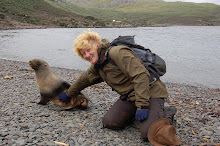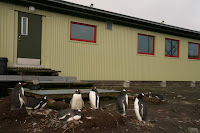The first pup arrived on the seal study beach sometime this morning before 09:00. When Don and I arrived at the beach, the pup was still damp, although had been with its mother long enough to be cleaned up and bond a bit. From now until the first week of January, we will be busy at SSB twice a day, at 09:00 and at 17:00, with barely time for lunch inbetween! The peak date of births is around December 8th-10th and by Christmas day the majority of the puppies will have arrived, with only a few late ones still to come. By then the aggressive males will have started to calm down: those that make it through the intense breeding season will be returning to the sea, in some cases after a month fighting for territory on the beach - those that don't make it will be cleaned up by the scavenging birds before long.
A bit about the fur seals that I work with: the Antarctic fur seal (Arctocephalus gazella) is a large species of 'eared seal'- different from the 'true seals' such as common seals and grey seals resident in the UK - of which 95% of the world population breeds on South Georgia, believed to be the densest population of marine mammals anywhere in the world. It is thought that there are between 2 and 4 million Antarctic fur seals worldwide. From near extinction due to exploitation by humans in the early 20th Century, they are now protected under the Convention for the Conservation of Antarctic Seals and have recovered to become one of the most numerous seal species. The aggressive males weigh up to 200kg, but the females are much smaller, around 40kg. The pups are only around 4kg when they are born. Because of their aggressive lifestyle, males live until they're around 15 years old, whereas females can live until 25. They feed mostly on krill, fish and cephalopod molluscs (such as squid).
On Bird Island there is such a dense breeding population that the younger, less dominant animals are forced up the hills from the beaches into the tussock grass, where they turn the tussock meadows into a muddy bog. There has been some call for a cull of the animals, because they are in fact colonising so high up the hills that they are encroaching on the nesting sites of some of the albatrosses and damaging the vegetation.
My work is contributing to a data set that stretches back many years, looking at population trends, what the animals are eating, where they go to forage and how long they spend there. This summer season, I am learning the ropes from Donald, so we are working together.
Moving around the island at this time of year is a bit like a giant game of chess: you have to strategically plan your move through the tussock and between fur seals. But you also have to think ahead, because, for example, if you dash swiftly between two growling males, you have to be sure you're running into a safe area, otherwise you could be trapped on all sides by the gnashing of teeth - check mate!
Away from the work side of things - we had a barbecue last Friday, in the company of around thirty skuas, desperate to get their hands on a piece of meat. Yesterday we serviced one of the John Deere diesel generators that supply our electricity on base, again putting into use skills I learned during the pre-deployment training in the UK.
The weather has turned more 'summery' lately: unfortunately that means more rain, although the conditions are so changable, that even if raining in the morning, it may be sunny come the afternoon. Today the wind reverted to the South, so we've had snow flurries interspersed with bright spells. The icey ground has begun to soften after the recent rain, so there are more and more bogs between the tussock grass to fall into.











No comments:
Post a Comment